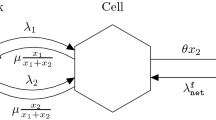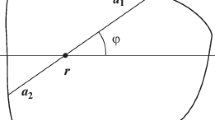Abstract
Handoffs in cellular communication systems cause interactions among cells that can be modeled using multi-dimensional birth–death process approaches and the concept of system state. However, exact numerical calculation of traffic performance characteristics is hindered by unmanageably large system state spaces even for systems of modest size. Previous analytical models get around the difficulty by isolating a cell of interestand invoking a Poisson process assumption for handoff arrivals to the cell. Interactions among cells are characterized by relating the mean handoff and departure rates from cells. The current paper seeks to explore the interactions in more detail. Two additional approximate analytical models are developed for this purpose. Each of these is more complicated than the simple Poisson process model, but is analytically tractable – at least for small system sizes. One model isolates a cluster of cells (rather than just the cell of interest) from the system and invokes a Poisson process assumption for cells on the cluster periphery. Performance is calculated for the central cell. The second model also isolates a cluster of cells surrounding the cell of interest, but uses an equivalent two-state Markov Modulated Poisson Process (MMPP) to characterize handoff arrival processes to the cell of interest from each of the neighboring cells. Poisson handoff arrivals to cells on the cluster periphery are assumed. This approach has fewer states than the cluster approach. Finally we present the exact solution for a regional coverage area consisting of a single seven-cell cluster. Teletraffic performance characteristics are computed for each modeling technique and are compared. It was found that all are in close agreement with the original “single isolated cell, Poisson handoff arrival model,” which requires the least states.
Similar content being viewed by others
References
CEAS Technical report No. 773, College of Engineering and Applied Sciences, State University of New York, Stony Brook, NY, USA (June 1, 1999).
E. Chlebus and W. Ludwin, Is handoff traffic really Poissonian, in: IEEE ICUPC'95 Conf. Record (November 1995) pp. 348–353.
H. Heffes, A class of data traffic processes — Covariance function characterization and related queueing results, The Bell System Technical Journal 59(6) (July–August 1980) 897–929.
D. Hong and S.S. Rappaport, Traffic model and performance analysis for cellular mobile radiotelephone systems with prioritized and nonprioritized handoff procedures, IEEE Transactions on Vehicular Technology 35(3) (August 1986) 77–92.
K.S. Meier-Hellstern, The analysis of a queue arising in overflow models, IEEE Transactions on Communications 37(4) (April 1989) 367–372.
P.V. Orlik and S.S. Rappaport, A model for teletraffic performance and channel holding time distribution characterization in wireless cellular communication with general session and dwell time distributions, Journal on Selected Areas in Communications 16(5) (June 1998) 788–803.
M. Rajaratnam and F. Takawira, Handoff traffic modelling in cellular networks, IEEE Globecom'97 Conf. Record (November 1997) pp. 131–137.
S.S. Rappaport, Blocking, hand-off and traffic performance for cellular communications with mixed platforms, IEE Proceedings-I 140(5) (October 1993) 389–401.
Author information
Authors and Affiliations
Rights and permissions
About this article
Cite this article
Orlik, P.V., Rappaport, S.S. On the Handoff Arrival Process in Cellular Communications. Wireless Networks 7, 147–157 (2001). https://doi.org/10.1023/A:1016685506058
Issue Date:
DOI: https://doi.org/10.1023/A:1016685506058




